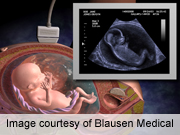
WEDNESDAY, June 6 (HealthDay News) — Researchers report they have decoded the entire genome of a fetus using only a blood sample from the mother and a saliva sample from the father.
The scientists said prenatal genome sequencing using the noninvasive method could one day be used to determine if a fetus has any of the thousands of genetic disorders that are caused by a single, often devastating, mutation on one gene.
In pregnant women, bits of fetal DNA move through the mother’s body in the plasma, a component of blood. Unlike a sample of DNA taken directly from fetal tissue or from amniotic fluid — such as when expectant mothers undergo amniocentesis to look for chromosomal disorders such as Down syndrome — the DNA in plasma is in fragments.
That makes analyzing it complex, but increasingly possible given the latest generation of gene-sequencing technology, explained study author Jay Shendure, an associate professor of genome sciences at the University of Washington.
“The chromosomes are shattered, but all the information is there, represented in small fragments,” Shendure said.
In the current study, researchers used plasma from a woman who was 18 weeks pregnant and saliva from the dad to tease out which was fetal DNA. Researchers confirmed the accuracy of their conclusions by mapping the baby’s DNA using umbilical cord blood after birth.
Testing for genetic problems using a blood sample and saliva would be an improvement over more-invasive tests such as amniocentesis, which can pose risks to the fetus, Shendure said.
“This fits in quite well with what we do today, which is to provide expectant mothers with as much information as we can,” Shendure said. “It would simply be more comprehensive.”
Still, he noted, the paper should be viewed as a “proof of concept,” or showing that noninvasive whole fetal genome sequencing was possible. More research is needed before the technique is ready to be used in doctor’s offices, he said.
The study is published in the June 6 issue of Science Translational Medicine.
Until the last few years, whole genome sequencing has been extraordinarily expensive. That began to change after the Human Genome Project produced the first whole human genome in 2001 at a cost of about $3 billion. By 2010, sequencing an entire genome cost around $50,000, while experts now put the cost at a few thousand dollars and dropping.
“The study is the next logical step in beginning to figure out how to use this amazing new technology we have that allows very robust sequencing of the genome. We now are in a situation [where], for relatively affordable and dropping prices, one can evaluate an individual’s whole genome,” said Dr. James Evans, editor-in-chief of Genetics in Medicine, the journal of the American College of Medical Genetics and Genomics.
Already there are several commercial companies that sift through the fetal DNA in plasma to look for an extra copy of chromosome 21 that indicates Down syndrome, Evans said.
But there are some 3,000 other single-gene genetic disorders that individually are rare, but collectively affect up to about 1 percent of births, Shendure said. Those diseases include Tay-Sachs, Marfan syndrome, cystic fibrosis, Huntington’s disease and Kabuki syndrome.
The fetal genome sequencing could tell parents before the baby is born if the child has the mutation that causes the disease, informing their decisions and helping them to prepare, Shendure said — not unlike what amniocentesis and other prenatal tests such as ultrasound offer today.
But significant questions remain, including how early in the pregnancy whole genome sequencing could be done. Research has found that there is fetal DNA in the mother’s plasma between four and seven weeks, but researchers have not yet determined if the technique would give an accurate picture of a fetal genetic profile that early, Shendure said. (Their analysis of maternal plasma at 8.2 weeks gestation turned up fetal DNA in the mother’s blood.)
Levels of fetal DNA in the mother’s plasma fluctuate during pregnancy, and disappear at birth. Because about 90 percent of the DNA in plasma is from the mother, while only about 10 percent comes from the fetus, researchers had to do complicated biostatistical analysis to determine what belonged to baby and what belonged to mom.
And although babies inherit one copy of each gene from mother and father, new mutations can arise that aren’t found in the mother or the father’s genes, which further complicates the analysis.
However, perhaps the biggest challenge is how to interpret all of the information, Evans said. Not only does it take time, researchers don’t know what every mutation means as far as disease.
“When you do a whole genome sequence, you end up with millions of variants. The biggest challenge facing our field is to understand which variants are importantly clinically and which are meaningless,” Evans said.
For example, Shendure noted, mutations on the BRCA1 and 2 genes are known to be associated with a much higher risk of breast cancer. But even after many years and tens of thousands of tests, researchers still come across mutations on those genes that they haven’t seen before and therefore aren’t sure if they really mean a heightened risk of breast cancer.
“We have only begun to scratch the surface in our ability to interpret the findings in a whole genome sequence,” Evans said. “This should been seen as very much in the realm of research. It is not ready for clinical application.”
What prenatal whole genome sequencing likely won’t be used for anytime soon time is to predict a baby’s likelihood of going on to develop common diseases such as heart disease and diabetes, experts said.
While there is plenty of research that links various mutations with a heightened risk of various diseases, genetics remains a poor predictor, Evans said. Instead, other, more obvious influences such as diet, exercise and whether a person smokes remain the best bet for predicting who’s going to develop the more common chronic diseases, Evans said.
“Measuring weight and asking them a few questions about activity and lifestyle does a far better job of figuring out, for example, heart disease risk,” Evans said.
Shendure agreed. “These single-gene disorders are the things we understand the best, and even there it’s challenging,” he said.
More information
Read more about the Human Genome Project.

